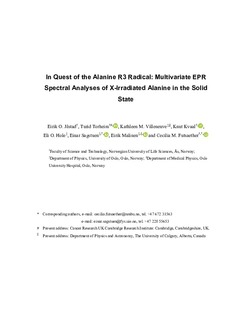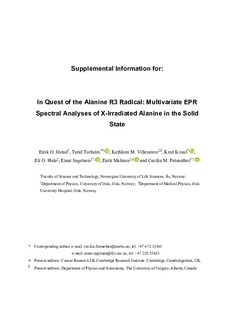| dc.contributor.author | Jåstad, Eirik Ogner | |
| dc.contributor.author | Torheim, Turid K Gjerstad | |
| dc.contributor.author | Villeneuve, Kathleen | |
| dc.contributor.author | Kvaal, Knut | |
| dc.contributor.author | Hole, Eli Olaug | |
| dc.contributor.author | Sagstuen, Einar | |
| dc.contributor.author | Malinen, Eirik | |
| dc.contributor.author | Futsæther, Cecilia Marie | |
| dc.date.accessioned | 2018-02-02T13:45:27Z | |
| dc.date.available | 2018-02-02T13:45:27Z | |
| dc.date.created | 2017-10-03T10:22:29Z | |
| dc.date.issued | 2017 | |
| dc.identifier.citation | Journal of Physical Chemistry A. 2017, 121 (38), 7139-7147. | nb_NO |
| dc.identifier.issn | 1089-5639 | |
| dc.identifier.uri | http://hdl.handle.net/11250/2482432 | |
| dc.description.abstract | The amino acid L-α-alanine is the most commonly used material for solidstate electron paramagnetic resonance (EPR) dosimetry, due to the formation of highly stable radicals upon irradiation, with yields proportional to the radiation dose. Two major alanine radical components designated R1 and R2 have previously been uniquely characterized from EPR and electron−nuclear double resonance (ENDOR) studies as well as from quantum chemical calculations. There is also convincing experimental evidence of a third minor radical component R3, and a tentative radical structure has been suggested, even though no well-defined spectral signature has been observed experimentally. In the present study, temperature dependent EPR spectra of X-ray irradiated polycrystalline alanine were analyzed using five multivariate methods in further attempts to understand the composite nature of the alanine dosimeter EPR spectrum. Principal component analysis (PCA), maximum likelihood common factor analysis (MLCFA), independent component analysis (ICA), self-modeling mixture analysis (SMA), and multivariate curve resolution (MCR) were used to extract pure radical spectra and their fractional contributions from the experimental EPR spectra. All methods yielded spectral estimates resembling the established R1 spectrum. Furthermore, SMA and MCR consistently predicted both the established R2 spectrum and the shape of the R3 spectrum. The predicted shape of the R3 spectrum corresponded well with the proposed tentative spectrum derived from spectrum simulations. Thus, results from two independent multivariate data analysis techniques strongly support the previous evidence that three radicals are indeed present in irradiated alanine samples. | |
| dc.language.iso | eng | nb_NO |
| dc.rights | Attribution-NonCommercial-NoDerivatives 4.0 Internasjonal | * |
| dc.rights.uri | http://creativecommons.org/licenses/by-nc-nd/4.0/deed.no | * |
| dc.title | In Quest of the Alanine R3 Radical: Multivariate EPR Spectral Analyses of X‑Irradiated Alanine in the Solid State | nb_NO |
| dc.type | Journal article | nb_NO |
| dc.type | Peer reviewed | nb_NO |
| dc.description.version | acceptedVersion | |
| dc.source.pagenumber | 7139-7147 | nb_NO |
| dc.source.volume | 121 | nb_NO |
| dc.source.journal | Journal of Physical Chemistry A | nb_NO |
| dc.source.issue | 38 | nb_NO |
| dc.identifier.doi | 10.1021/acs.jpca.7b06447 | |
| dc.identifier.cristin | 1501684 | |
| cristin.unitcode | 192,14,0,0 | |
| cristin.unitcode | 192,15,0,0 | |
| cristin.unitname | Miljøvitenskap og naturforvaltning | |
| cristin.unitname | Realfag og teknologi | |
| cristin.ispublished | true | |
| cristin.fulltext | postprint | |
| cristin.qualitycode | 2 | |


